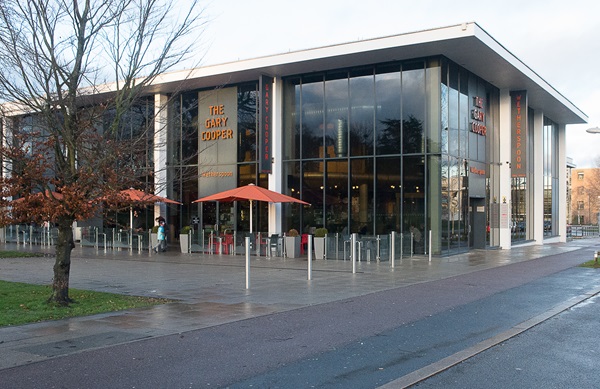Frank Cooper attended the grammar school next door to Grove House during 1910–13, before leaving for the United States, aged 12. His film career began as an ‘extra’, before he was contracted to Paramount in 1927, having changed his name from Frank to Gary. By the end of the 1930s, Gary Cooper was reputedly the highest-paid film star in America. His most outstanding film performance was in 1952 as the town marshall in High Noon.Frank Cooper attended the grammar school next door to Grove House during 1910–13, before leaving for the United States, aged 12. His film career began as an ‘extra’, before he was contracted to Paramount in 1927, having changed his name from Frank to Gary. By the end of the 1930s, Gary Cooper was reputedly the highest-paid film star in America. His most outstanding film performance was in 1952 as the town marshall in High Noon.
Photographs and text about The Gary Cooper.
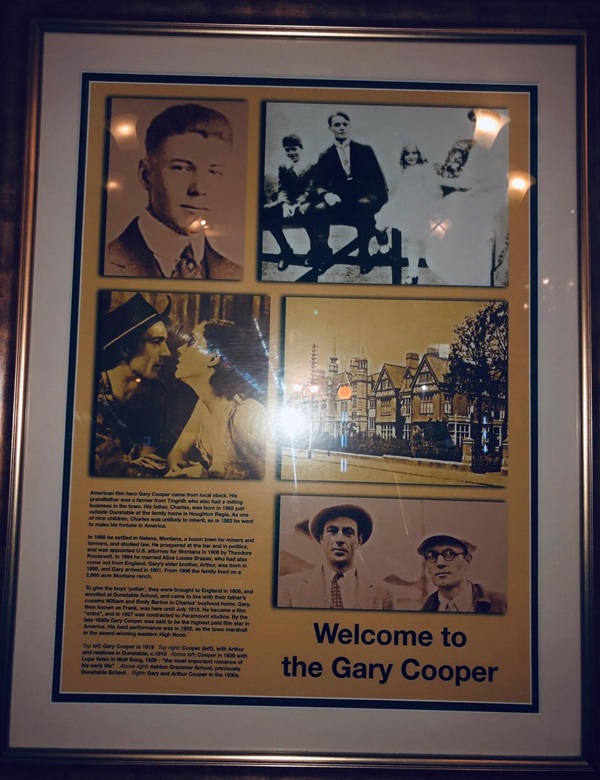
The text reads: American film hero Garry Cooper came from local stock. His grandfather was a farmer from Tingrith who also had a milling business in the town. His father, Charles, was born in 1865 just outside Dunstable at the family home in Houghton Regis. As one of nine children, Charles was unlikely to inherit, so in 1883 he went to make his fortune in America.
In 1885 he settled in Helena, Montana, a boom town for miners and farmers, and studied law. He prospered at the bar and in politics, and was appointed US attorney in Montana in 1906 by Theodore Roosevelt. In 1894 he married Allice Louise Brazier, who had also come out from England. Gary’s elder brother, Arthur, was born in 1895, and Gary arrived in 1901 the family lived on a 2,660 acre Montana ranch.
To give the boys ‘polish’, they were brought to England in 1909, and enrolled at Dunstable School, and came to live with their father’s cousins William and Emily Barton in Charles’ boyhood home. Gary then known as Frank, was here until July 1912. He became a film extra, and in 1927 was contracted to Paramount studios. By the late 1930s Gary Cooper was said to be the highest paid film star in America. His best performance was in 1952, as the town marshall in the award winning western High Noon.
Top Left: Gary Cooper in 1919. Top Right: Cooper (left), with Arthur and relatives in Dunstable, c1910
Above left: Cooper in 1929 with Lupe Velez in Wolf Song, 1929 – “the most important romance of his early life”
Above right: Ashton Grammar School, previously Dunstable School
Right: Gary and Arthur Cooper in the 1930s
Photographs and text about Settle and Smith.
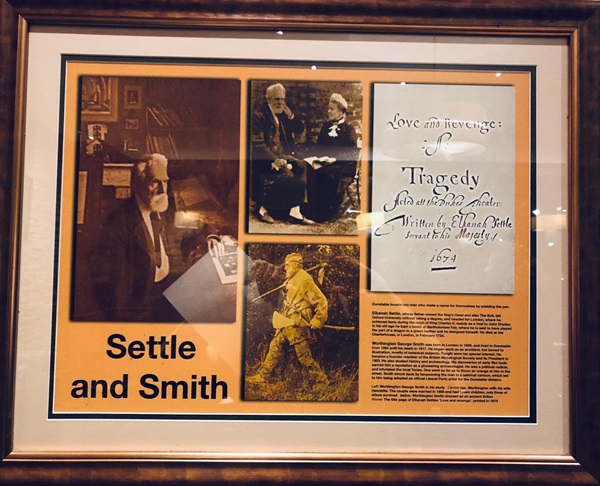
The text reads: Dunstable boasts two men who made a name for themselves by wielding the pen.
Elkanah Settle, whose father owned the Nag’s Head and also The Bull, left Oxford University without taking a degree, and headed for London, where he achieved fame during the reign of King Charles II, mainly as a rival to John Dryden. In his old age he kept a booth at Bartholomew Fair, where he is said to have played the part of a dragon in a green leather suit he designed himself. He died at the Charterhouse, in London in February 1724.
Worthington George Smith was born in London in 1835, and lived in Dunstable from 1884 until his death in 1917. He began work as an architect, but turned to illustration, mostly of botanical subjects. Fungi were his special interest. He became a founder member of the British Mycological Society and its President in 1903. He also studied history and archaeology. His discoveries of early flint tools earned him a reputation as a pioneering archaeologist. He was a political radical, street. Smith struck back by lampooning the man in a satirical cartoon, which led to him being adopted as official Liberal Party artist for the Dunstable division.
Left: Worthington George Smith in his study
Centre: top, Worthington with his wife Henrietta. The couple were married in 1856 and had seven children, only three of whom survived below, Worthington Smith dressed as an ancient Briton
Above: The title page of Elkanah Settles Love and Revenge, printed in 1675.
Photographs and text about High Street North.
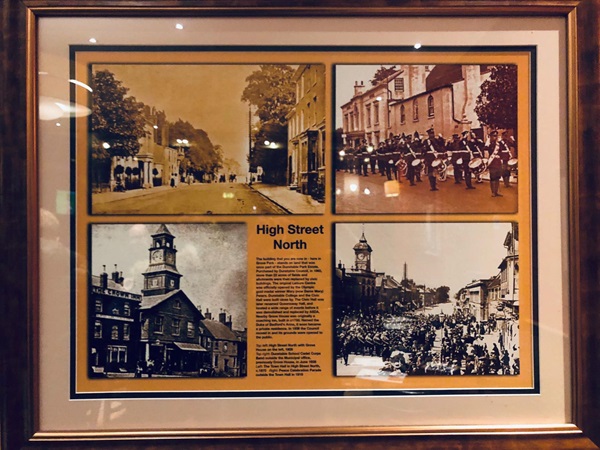
The text reads: The building that you are now in – here in Grove Park – stands on land that was once part of the Dunstable Park Estate. Purchased by Dunstable Council, in 1960, more than 22 acres of fields and allotments were then replaced by civic buildings. The original Leisure Centre was officially opened by the Olympic gold medal winner Mary (now Dame Mary) Peters. Dunstable College and the Civic Hall were built close by. The Civic Hall was later renamed Queensway Hall, and hosted a wide range of events before it was demolished and replaced by ASDA. Nearby Grove House was originally a coaching inn, built in c1750. Named the Duke of Bedford’s Arms, it soon became a private residence. In 1936 the council moved in and its grounds were opened to the public.
Top left: High Street North with Grove House on the left, 1909
Top right: Dunstable School Cadet Corps Band outside the Municipal office, previously Grove House, in June 1938
Left: The Town Hall in High Street North, c1870
Right: Peace Celebration Parade outside the Town Hall in 1919
Prints and text about how Dunstable changed the course of history.
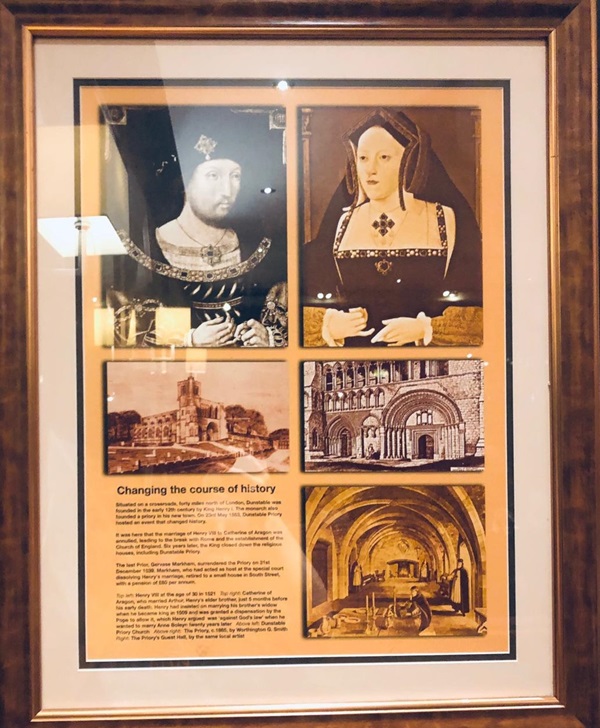
The text reads: Situated on a crossroads forty miles north of London, Dunstable was founded in the early 12th century by King Henry I. The monarch also founded a priory in his new town. On 23 May 1553, Dunstable Priory hosted an event that changed history.
It was here that the marriage of Henry VIII to Catherine of Aragon was annulled, leading to the break with Rome and the establishment of the Church of England. Six years later, the King closed down the religious houses, including Dunstable Priory.
The last Prior, Gervase Markham, surrendered the Priory on 31 December 1539. Markham, who acted as host at the special court dissolving Henry’s marriage, retired to a small house in South Street, with a pension of £60 per annum.
Top left: Henry VIII at the age of 30 in 1521
Top right: Catherine of Aragon, who married Arthur, Henry’s elder brother, just 5 months before his early death. Henry had insisted on marrying his brother’s widow when he became king in 1509 and was granted a dispensation by the Pope to allow it, which Henry argued was ‘against God’s law’ when he wanted to marry Anne Boleyn twenty years later
Above left: Dunstable Priory Church
Above right: The Priory, c1885, by Worthington G Smith
Right: The Priory’s Guest Hall, by the same local artist.
External photograph of the building – main entrance.
